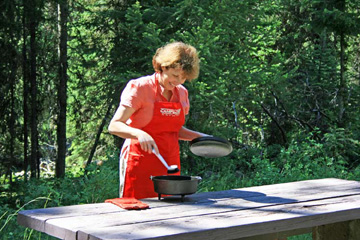Cast Iron Cleaning
Put 3-4 cups of warm water in the Dutch oven. Use a bristled brush and clean out the inside of the oven thoroughly. Scrub the outside of the oven to remove burnt embers and dripped food.
Rinse thoroughly and dry by patting with a paper towel. If difficult food stains remain, add water to the Dutch oven and bring it to a boil. A gas burner stove is the quickest way to do this, but returning the oven to a hot bed of coals is an alternative. Scrub thoroughly with the brush and the stains and burnt food remains should be easy to remove. Pat dry with a paper towel.
Once cleaned, wipe all areas of the Dutch oven with a very thin coat of vegetable oil and store with the lid ajar in a clean dry area.
Often I like to disinfect or sterilize the Dutch oven by boiling water in it. This 212° F boiling temperature does an excellent job of killing any bacteria or viruses. Always pat dry and lightly oil the oven after cleaning or sterilizing it.
The use of soap can be detrimental to the desired patina of the oven. This patina serves as a non-stick, Teflon-like surface. If you must use soap for a really stubborn stain, select a citrus-based soap. But once soap is used, the oven needs to be conditioned by drying it thoroughly, wiping it down with vegetable oil, placing it inside your kitchen oven, and heating it up to 350°F for just a few minutes. An alternative method is to place the oven upside down over a gas burner flame on medium heat. Remember, the desired color is black. A gray or amber color indicates improper seasoning. The black patina is a non-stick surface that is easy to clean and harbors few harmful bacteria.


Camping Adventures • Dutch Oven Cooking • Sports Knots
Fly Tying • Freshwater Fishing • Fly Fishing

